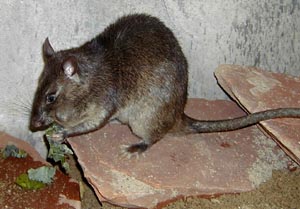Gambian Giant Pouched Rat
Air Date: Week of June 20, 2003
The Gambian Giant Pouched Rat has been in the news lately. The African rodent is blamed for starting the outbreak of Monkey Pox here in the U.S. Host Steve Curwood speaks with a keeper at Utah's Hogle Zoo to find out more about this creature.
Transcript
CURWOOD: The first outbreak of the African disease, Monkey Pox, in the western hemisphere has been traced to infected prairie dogs in an Illinois pet shop. And it’s believed the prairie dogs got the disease from an African import that also lived at the pet store, a Gambian Giant Pouched Rat. To find out more, about this little known creature, we called an expert. Joanne Randinitis is one of the keepers at Utah's Hogle Zoo, in Salt Lake City where the giant rats are part of the education program. Hi Joanne.
RANDINITIS: Hi.
CURWOOD: I understand that the Hogle Zoo has not one but two Gambian rats. What are their names?
RANDINITIS: They are named Gabby and Eureka.
CURWOOD: Joanne, I got to tell you, when my oldest son said that he wanted a pet rat a number of years ago, I was privately horrified, but I went along with it. But you know, the rat was actually quite a wonderful pet.
RANDINITIS: Right.
CURWOOD: How about these Gambian rats?
RANDINITIS: They do not make very good pets at all. They’re very temperamental, and they are also very territorial. They’re also rather large, so you need a lot of space to take care of them so they’ll have a good quality of life.
CURWOOD: What’s large?
 Gambian Giant Pouched Rat (Photo courtesy of Utah Hogles Zoo)
RANDINITIS: A Giant Pouched Rat can weigh almost three and a half pounds. And they can probably grow to be about a foot and a half long. Gambian Giant Pouched Rat (Photo courtesy of Utah Hogles Zoo)
RANDINITIS: A Giant Pouched Rat can weigh almost three and a half pounds. And they can probably grow to be about a foot and a half long.
CURWOOD: That’s a lot of rat. RANDINITIS: Mm hmm, it sure is. CURWOOD: And tell us about those pouches. What’s that all about? RANDINITIS: In their cheeks they have these big skin flaps that they use. And they’ll go out in the wild and gather food and store it all in their pouches, then go back to their nests and unload it in a little food cache. And then they’ll just sit there and eat that. CURWOOD: What do you feed these giant rats? RANDINITIS: They get a whole selection of fruit and vegetables. Gabby particularly likes grapes, and she’ll just take grapes and keep shoving them in her pouches until she has a whole face full of grapes. CURWOOD: I suppose, as you know, the Gambian rat has not been getting much good press these days. RANDINITIS: Yes, I’ve been reading about that, too. CURWOOD: But you’re the ambassador now for the Gambian rat. Tell me, what do you like about this rodent? RANDINITIS: I really appreciate how intelligent they are. I’m working on training with the rats, to teach them to come to me, and to target, to crate. Their learning ability is just—they’re very quick. They can be very vocal. When they get excited or they feel threatened, they’ll fill their cheek pouches with air. And then they’ll release the air and it makes like a muffled sound. The rats, in the morning, they will vocalize for me. They’ll come and they’ll squeak at me, because they are familiar with me. So I think that we have a good working relationship. CURWOOD: When you take these animals around to classrooms or to rest homes, how do people respond to these giant rats? RANDINITIS: I think, first off, people can’t get over how large they are. And all the people at the presentations are allowed to touch the rats—in a controlled way, though. And I think then people can warm up to a rat. CURWOOD: Joanne Randinitis is on the animal care staff in the docent animal facility at Utah’s Hogle Zoo. Joanne, thanks for taking this time with us today. RANDINITIS: Great. Thank you very much. [MUSIC: Frank Zappa “Peaches En Regalia” Hot Rats Rykodisc (1969)] Living on Earth wants to hear from you!Living on Earth Newsletter [Click here]
Donate to Living on Earth! NewsletterLiving on Earth offers a weekly delivery of the show's rundown to your mailbox. Sign up for our newsletter today!
|





